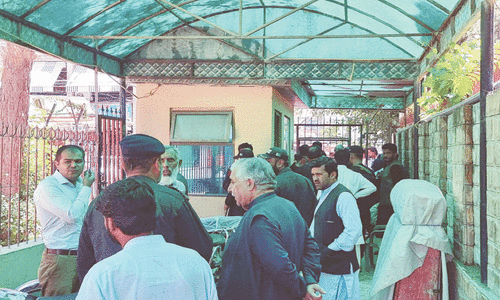ISLAMABAD, Feb 28: The carpet industry has the highest incidence of illness and injuries caused to child labourers in the country , a number of studies recently commissioned by the International Labour Organization (ILO) said.
These studies have been conducted in the carpet sector to identify the hazards involved, focusing on bonded labour in the sector.
Some of the health problems faced by the children working in the carpet sector include eye disease and eye strain due to insufficient light in workshops/sheds; pain due to prolong sitting in specific postures; pulmonary diseases due to wool dust; headaches due to concentration required by the work; skeletal deformation; weakness and malnutrition due to inadequate food.
The assessment process gave special attention to the health of workers and the workplace environment. Visits to different areas indicated that almost all children working in the carpet- weaving sector experienced finger injuries through the use of sharp instruments.
Injury rates are highest in the NWFP and Balochistan where children are employed in high proportion. No worker takes any safety measures during the work and no medical help is available in case of emergency. The environment of the sheds (for example older workers in almost all sheds were found smoking cigarettes) is also a health hazard.
The health of the workers in all provinces is poor. In the NWFP, and in Karachi, many workers were found suffering from coughs. In Thar desert, most of the workers are malnourished and many of them have some type of skeletal deformation.
Those who worked inside their homes were diagnosed with TB and other pulmonary diseases. The situation of women weavers in the carpet industry is also far from satisfactory. Most of them are frail and malnourished, and complain of continuous bouts of headache and weak eyesight. The condition of women working in their homes is better than those employed in the sheds.
Different communities are involved in the carpet-weaving activities in various parts of the country. In the NWFP, carpet- weaving is concentrated among Afghan refugees of particular tribes or ethnic groups called 'Tajik' and 'Gillim Jum'. These people started weaving in the refugee camps of the NWFP during the early 1980s when they realized that foreign forces occupying Afghanistan would not be leaving soon and that they would have to stay longer in Pakistan.
The rapid expansion of carpet-weaving among the local population started when the Afghan families who preferred to stay in Pakistan settled in low-income areas and kutchi abadis such as Afghan colonies.
In Punjab, low-income families involved in non-agricultural activities first took up carpet-weaving. In the beginning, the work was confined to cloth-weavers, but gradually unemployed persons from agricultural families also joined this sector. Now workers from diverse backgrounds are engaged in carpet-weaving. The only common factor among them is their illiteracy and unemployment.
Thar desert, where both Muslims and Hindus of different castes live side-by-side and are involved in carpet-weaving, presents a unique picture. Each village where carpet-weaving takes place is dominated by people belonging to a particular religion or caste.
In the Orangi and Korangi areas of Karachi, Mohajar communities (Biharis and Burmese) are involved in carpet- weaving. The Bihari community migrated from Bangladesh, while Burmese migrated from Myanmar. Most of them brought carpet- weaving skills with them when they migrated.
The carpet industry in Balochistan is limited to the areas surrounding Quetta where Hazara tribes are settled. They are mostly business-minded people and are particularly good at carpet-weaving and shoe-making.
A large number of Afghan Hazaras have also taken refuge in this area and work as carpet-weavers. Different types of arrangements were encountered in the carpet-weaving sector of different provinces. The exporter provides finances in all cases where he/she places an order with the contractor/middleman.
Some funds are paid upfront, and the remainder upon the contractor's demand. In cases where contractors/middlemen produce carpets for sale and not at the exporter's demand, contractors themselves have to finance the whole production process. In this case, the contractors sell their product to the exporter who pays the best price.
Two systems of payment are prevalent - daily wages and piece-rate. When the loom is installed at the worker's residence, the work is carried out on a piece-rate basis with the rate fixed per line/inch of knots completed.
When looms are installed at a common place or a shed, the workers are engaged either on a piece-rate basis or on daily wages. In all of these cases, the exporter/wholesaler provides raw materials through the middleman. Wages depend on prevailing market conditions, skill level, bargaining power of workers, and their vulnerability to exploitation.









































Dear visitor, the comments section is undergoing an overhaul and will return soon.